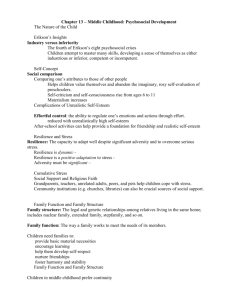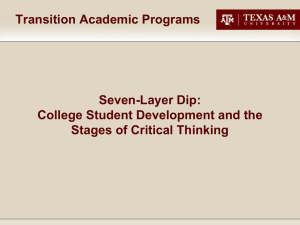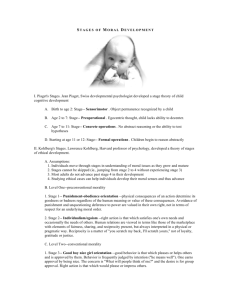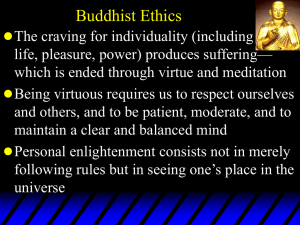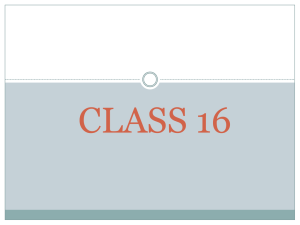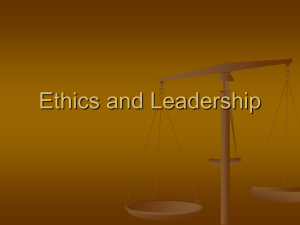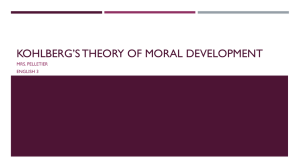MORALITY
advertisement
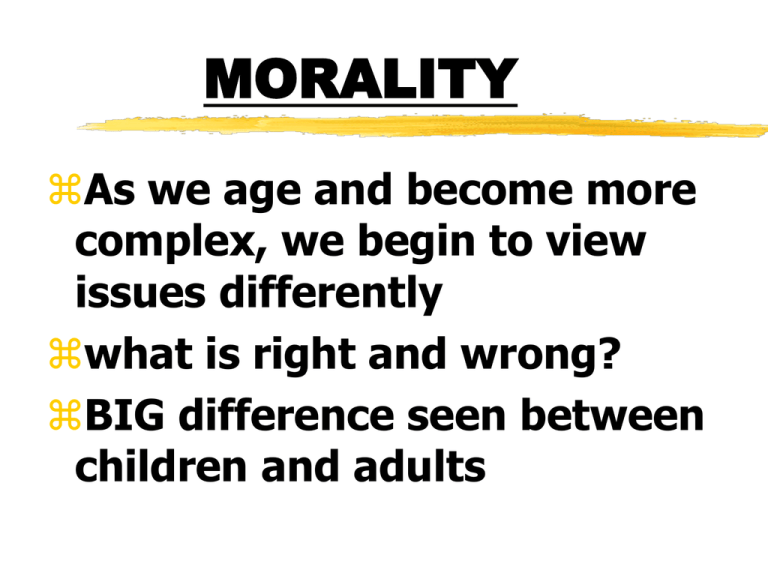
MORALITY As we age and become more complex, we begin to view issues differently what is right and wrong? BIG difference seen between children and adults MORALITY Children: something is wrong if you are punished for it Adults: just “know” something is wrong, even if they get away with it and the opposite kids with breaking things <6 MORALITY Many changes during adolescence. Transition from childhood to adulthood girls in N. America: 12-13 boys: 13-15 the end is harder to identify MORALITY Still closely tied to the parents with more independence than ever start turning out to society Hormones rewire the brain MORALITY Lawrence Kohlberg also distinct stages of moral reasoning evaluate the reasoning behind moral decisions! We all start at a low level of morals Lawrence Kohlberg MORALITY Moral dilemmas- developed by Kohlberg to see what level of morals you have there is no such thing as a moral or immoral DECISION, but moral or immoral REASONS****** BOYS Kohlberg’s Method In order to determine which stage of moral development a person was at, Kohlberg presented the person with moral dilemmas “The Case of Heinz and the Druggist.” Mr. Heinz's wife is dying. There is one drug that will save her life but it is very expensive. The druggist will not lower the price so that Mr. Heinz can buy it to save his wife's life. What should he do? More importantly, why? Moral dilemmas were judged, not according to the respondent’s position (to steal the drug or not), but on the basis of the kind of answer exhibited. reasoning the MORALITY FEW people are actually consistent Hypocrites many never reach level 6 25% of adults?? women tend to lag Kohlberg suggested a stage theory of moral development: Preconventional Morality 1. Punishment-obedience 2. Personal reward orientation Conventional Morality 3. The “good boy/nice girl” Orientation 4. The “law and order” orientation Post-conventional Morality 5. Social contract orientation 6. Universal ethical principle MORALITY PRECONVENTIONAL LEVELS 1. Punishment and obedience orientation “wrong is punished” immediate consequences Will I be punished? Kohlberg’s Levels 2. Obey for your own benefit delayed benefits are taken into account—rewards!! people may help you down the road “you scratch my back, I’ll scratch yours.” Kohlberg’s Levels CONVENTIONAL MORALITY 3. “Good Boy, Nice Girl Orientation” public opinion is the main basis of morals what will others think of me? Kohlberg’s Levels 4. Law and Order Orientation you should respect and follow the law because it is the law no questions asked social order also important Kohlberg’s Levels POSTCONVENTIONAL LEVEL 5. Social-Contract Orientation laws should be followed, but there should be flexibility majority can change what was it intended to do? the role of a husband/wife Kohlberg’s Levels 6. Universal Ethical Principle Orientation laws can be broken in special cases - civil disobedience there are higher ethics like justice & respect for human life Arguments Against He is not covering EVERYTHING do you actually do what you say you will do? Hypocrites!!! Arguments Against Discriminates against people who can’t articulate themselves What about women? The caring vs. justice component Men vs. Women Carol Gilligan men: rights and duties women: caring is more important women want to hear the details of a situation Carol Gilligan began with an interest in moral development She had been a teaching assistant for Erik Erikson particularly interested in issue Kohlberg raised: why do some individuals recognize a higher moral law, while others simply are content to obey the rules without question? Gilligan’s Initial Research Her initial research -- draft resisters during the Vietnam war. Nixon cancelled draft just as her project was started. study women who made difficult moral choices about abortion. Gilligan’s Criticism ABORTION: Men: right because women’s right to choose, wrong because it takes a life Women: it depends Gilligan’s Stages STAGE 1 PRECONVENTIONAL what is best/worst for me? STAGE 2 CONVENTIONAL what is best for others? Gilligan’s Stages 3. POSTCONVENTIONAL focus on the fact that hurting anyone, including oneself is immoral. Once again, REASONS matter Later Research... Males and females take justice and caring into account differences have never been substantiated TWO “voices” justice vs. caring Differences between Men’s and Women’s Moral Voices Men Justice Rights Treating everyone fairly and the same Apply rules impartially to everyone Responsibility toward abstract codes of conduct Women Care Responsibility Caring about everyone’s suffering Preserve emotional connectedness Responsibility toward real individuals
